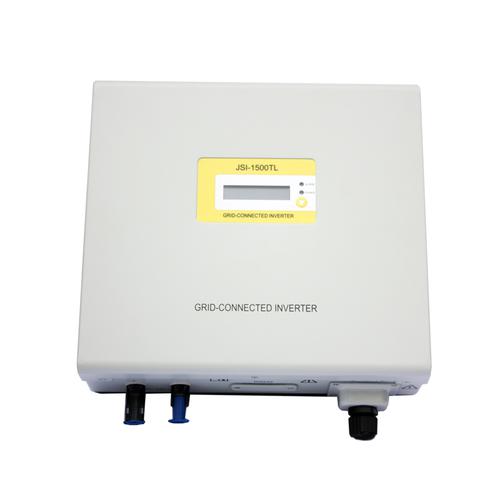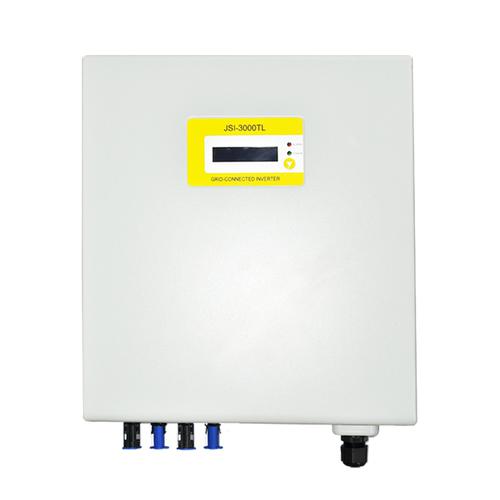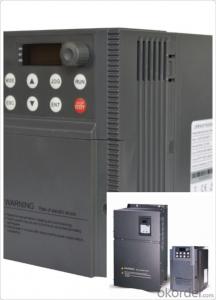Luminous Solar Inverter 1100W Single Phase
OKorder Service Pledge
Quality Product, Order Online Tracking, Timely Delivery
OKorder Financial Service
Credit Rating, Credit Services, Credit Purchasing
You Might Also Like
Single phase solar inverter 1100W
◆ Compact size and high power density
◆ High speed MPPT for real time power tracking and improved energy harvesting
◆ Transformerless operation for highest efficiency 97%
◆ High overload capability under most ambient conditions
◆ Certified grid connected operation according to the international standards
◆ True sine wave output
◆ Integrated RS485/RS232 serial communications
◆ Multi-language LCD display
| MODEL | 1100TL | 1500TL | 2000TL | 2500TL | 3000TL | 3600TL | 5000TL | 6000TL |
| Max. DC Input Power(W) | 1200 | 1750 | 2300 | 2700 | 3660 | 3750 | 5300 | 6400 |
| Max DC Voltage(Vdc) | 450 | 450 | 500 | 550 | ||||
| MPPT Operating Range(Vdc) | 60~450 | 100~450 | 100~500 | |||||
| Number of Parallel Inputs | 1 | 2 | 3 | |||||
| Number of MPPT Trackers | 1 | |||||||
| Max. Input Current(A) | 11.7 | 10 | 13 | 14.5 | 20 | 20 | 22.5 | 27.5 |
| Nominal Output Power(W) | 1100 | 1500 | 2000 | 2490 | 3000 | 3600 | 4600 | 6000 |
| Max. Output Power(W) | 1100 | 1650 | 2200 | 2490 | 3400 | 3600 | 5000 | 6000 |
| Nominal Output Current(A) | 4.8 | 6.5 | 8.7 | 10.8 | 13 | 15.7 | 20 | 26 |
| Max. Output Current(A) | 5.7 | 7.9 | 10.5 | 12 | 15.7 | 16 | 24 | 29.3 |
| Nominal AC Output Voltage(Vac) | 230 | |||||||
| AC Output voltage range (Vac)* | 190~265 | |||||||
| AC Grid frequency range (Hz)* | 50±5 | |||||||
| Power Factor (cosφ) | >0.99 | |||||||
| THDI | <3%(at nominal output power) | |||||||
| Max.efficiency | 96.50% | 96.50% | 97.00% | 97.10% | 97.20% | 97.30% | 97.40% | 97.40% |
| Euro.efficiency | 95.40% | 95.50% | 96.20% | 96.30% | 96.40% | 96.60% | 96.80% | 96.80% |
| MPPT. efficiency | 99.60% | 99.60% | 99.60% | 99.60% | 99.60% | 99.60% | 99.60% | 99.60% |
| Operating Temperature(℃) | -25~+60 | |||||||
| Noise typical[dB(A)] | ≤20dB(A) | |||||||
| Operating Consumption(W) | 0 | |||||||
| Electrical Isolation | Transformerless | |||||||
| Cooling Concept | Natural cooling | |||||||
| Protect Level | IP65 | |||||||
| Communication | RS232(WiFi optional) | |||||||
| Dimension (W×D×H)(mm) | 345*152*315 | 345*152*355 | 345*152*385 | 345*152*505 | 345*162*573 | |||
| Weight (Kg) | 12 | 13 | 15 | 19 | 24 | |||
| *AC grid voltage range and frequency range depend on local standards | ||||||||
- Q: Can a solar inverter be used with solar-powered recreational vehicles (RVs)?
- Yes, a solar inverter can be used with solar-powered recreational vehicles (RVs). A solar inverter is an essential component of an RV solar power system as it converts the direct current (DC) generated by the solar panels into alternating current (AC) that can be used to power various appliances and devices in the RV. It helps optimize the energy generated by the solar panels and ensures a reliable power supply while on the move.
- Q: How do you calculate the maximum power point current for a solar inverter?
- To calculate the maximum power point current for a solar inverter, you need to determine the maximum power point voltage (Vmpp) of the solar panel and divide it by the inverter's input impedance. This can be done by using the voltage-current (V-I) curve of the solar panel and locating the point where the product of voltage and current is maximized. By obtaining the Vmpp value, you can then calculate the maximum power point current by dividing it by the inverter's input impedance.
- Q: Can a solar inverter be used in standalone power systems?
- Yes, a solar inverter can be used in standalone power systems. Standalone power systems, also known as off-grid systems, are designed to operate independently from the main electrical grid. Solar inverters play a crucial role in these systems by converting the direct current (DC) electricity generated by solar panels into alternating current (AC) electricity that can be used to power appliances and devices. Thus, solar inverters are essential components in standalone power systems, enabling the use of solar energy for off-grid electricity needs.
- Q: What is the role of a transformer in a solar inverter?
- The role of a transformer in a solar inverter is to convert the direct current (DC) electricity generated by the solar panels into alternating current (AC) electricity suitable for use in homes and businesses. The transformer helps to step up or step down the voltage levels, ensuring efficient and safe transmission of electricity from the solar panels to the electrical grid or connected loads.
- Q: What is the maximum AC current output of a solar inverter?
- The maximum AC current output of a solar inverter depends on its power rating or capacity. Typically, solar inverters have a maximum AC current output ranging from 5 to 50 amps, although larger commercial or utility-scale inverters can have much higher current outputs.
- Q: Can a solar inverter be used with a monitoring system?
- Yes, a solar inverter can be used with a monitoring system. In fact, many solar inverters come with built-in monitoring capabilities, allowing users to track and analyze the performance of their solar energy system in real-time. Additionally, there are also external monitoring systems available that can be connected to the solar inverter to provide more detailed data and insights on energy production, consumption, and system efficiency.
- Q: How is the output voltage and frequency of a solar inverter regulated?
- The output voltage and frequency of a solar inverter are regulated through a combination of control systems and power electronics. The control system continuously monitors the input from the solar panels and adjusts the inverter's operation accordingly. It analyzes the DC voltage generated by the panels and converts it to AC voltage at the desired frequency. This is achieved by controlling the switching of power electronic devices such as transistors or thyristors. These devices convert the DC power into high-frequency AC power, which is then transformed to the desired output voltage and frequency through a transformer or filter circuit. Overall, the regulation of the output voltage and frequency is achieved by the precise control of these power electronic components within the solar inverter.
- Q: What is the role of an anti-islanding feature in a solar inverter?
- The role of an anti-islanding feature in a solar inverter is to ensure the safety of utility workers during power outages. It detects when the grid goes down and immediately disconnects the solar system from the grid to prevent the flow of electricity back into the grid. This prevents the potential danger of utility workers being exposed to live electricity while working on the grid.
- Q: How does a hybrid solar inverter work?
- A hybrid solar inverter works by converting the direct current (DC) power generated by solar panels into alternating current (AC) power that can be used to power household appliances or be fed back into the grid. It also has the capability to store excess energy in batteries for later use during periods of low solar generation or power outages. This allows for efficient utilization of solar energy and provides backup power when needed.
- Q: Can a solar inverter be used with a solar-powered water desalination system?
- Yes, a solar inverter can be used with a solar-powered water desalination system. A solar inverter is responsible for converting the DC power generated by solar panels into AC power that can be used by electrical devices. In the case of a solar-powered water desalination system, the solar panels generate DC power, which is then converted into AC power by the inverter to run the system's pumps, filters, and other electrical components. This allows the system to operate efficiently using clean and renewable energy from the sun.
Send your message to us
Luminous Solar Inverter 1100W Single Phase
OKorder Service Pledge
Quality Product, Order Online Tracking, Timely Delivery
OKorder Financial Service
Credit Rating, Credit Services, Credit Purchasing
Similar products
Hot products
Hot Searches
Related keywords

























